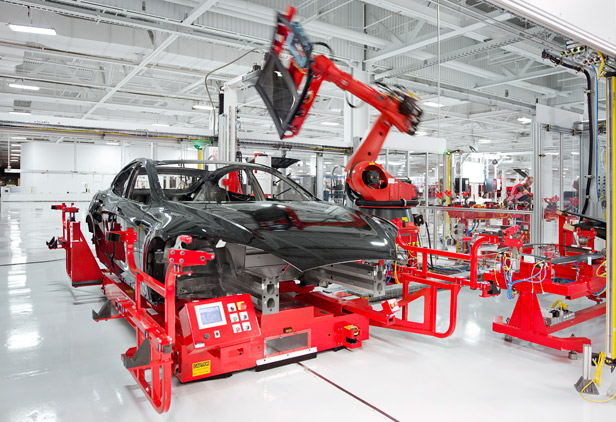Tesla Blames New Delays on Production Difficulties
The company’s woes highlight the challenge of getting into the automotive manufacturing industry from scratch.
Tesla Motors put on a spectacular show last night to announce a new network of six fast-charging stations for its electric vehicles designed to lure would-be electric vehicle owners into buying one of their vehicles (see “Will Fast Charging Make Electric Vehicles Practical?”).
But the good news didn’t last long. This morning the company told investors that it will fall well short of its production targets for its Model S electric vehicle, and that it needs to raise additional funds to keep operating over the next 12 months. The company’s problems seem to highlight the challenges of getting into the automotive manufacturing industry from scratch.
The Model S is the only car the company currently makes, and Tesla is relying heavily on sales of the vehicle to meet its revenue targets for the year. Today, Tesla stock prices fell by about 10 percent.
This story is only available to subscribers.
Don’t settle for half the story.
Get paywall-free access to technology news for the here and now.
Subscribe now
Already a subscriber?
Sign in
Tesla has emphasized its novel approach to manufacturing as a way for a small company to compete in a large, mature industry. For example, it’s using highly customizable robots that can quickly shift between four or five tasks, rather than doing only one or two things, as in a conventional factory. It has also abandoned a conventional assembly line in favor of moving vehicles around on automated carts, so that the assembly process can be modified more easily. Tesla is also adopting new manufacturing techniques that are not widely used in the auto industry, such as spot-welding aluminum. GM only recently announced that it would use aluminum spot-welding in large-scale production.
Tesla started production of the Model S in June, and so far it has delivered only 132 of the 5,000 vehicles it originally planned to deliver by the end of the year. It has now lowered that goal to between 2,500 and 3,000 cars, although it still hopes to meet its earlier target of 20,000 vehicles in 2013.
In a U.S. Securities and Exchange Commission filing today, Tesla said its production delays were due in part to difficulties in training new employees to use new equipment, and in part to delays from suppliers.
Tesla is particularly vulnerable to supply disruptions because it relies on exclusive suppliers for many of its parts, such as the battery cells it gets from Panasonic. The company noted that earthquakes—like the one in Japan last year, which hurt Panasonic’s operations—can hurt Tesla as well. The company also pointed to features of the Model S that are particularly difficult to manufacture, such as a 17-inch dashboard display and retractable door handles.
Tesla plans to raise additional capital through a new stock offering in announced this morning. If this isn’t successful, the company might not meet the terms of its $465 million U.S. Department of Energy loan, which it is using to produce the Model S. The DOE could then declare the company in default and demand immediate repayment, causing Tesla’s leased equipment to be repossessed. A failure to meet loan terms recently hurt fellow electric car maker Fisker Automotive, sending it scrambling for additional capital (see “Fisker’s Woes Put A123 Systems at Risk”). Tesla has renegotiated the terms of the loan twice.
Although the Model S is crucial for Tesla, it is not its only source of revenue. Tesla has been well-regarded by market analysts in part because its battery and electric drive technology can also be sold to other automakers. Tesla’s technology is used in Toyota’s Rav4 EV, and it expects to pull in $100 million from supplying equipment for that car. But Tesla hasn’t been able to line up major new customers for its technology, and Toyota plans only a limited run of the Rav4 EV, focusing on hybrids rather than electric vehicles.
Although it’s struggling to meet production targets, it has a ready customer base if it can solve them. It currently has 13,000 outstanding orders. In spite of its difficulties, market analyst Andrea James, of Dougherty, has a positive outlook for Tesla. She notes that the company is still only about a month behind its original schedule. “Tesla is making an all-new car in an all-new manufacturing facility, and this is the first hiccup,” she says. “They are sacrificing quantity in pursuit of quality in these early stages, and that makes sense. I think they’ll pull through, and people will look back and say, ‘Sure, it’s always tough in the beginning.’”
